
A grape is a fruit, botanically a berry, of the deciduous woody vines of the flowering plant genus Vitis.

Brandy is a liquor produced by distilling wine. Brandy generally contains 35–60% alcohol by volume and is typically consumed as an after-dinner digestif. Some brandies are aged in wooden casks. Others are coloured with caramel colouring to imitate the effect of aging, and some are produced using a combination of both aging and colouring. Varieties of wine brandy can be found across the winemaking world. Among the most renowned are Cognac and Armagnac from southwestern France.
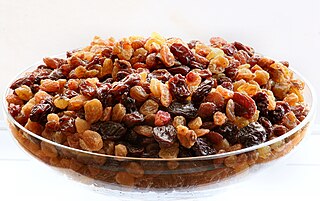
A raisin is a dried grape. Raisins are produced in many regions of the world and may be eaten raw or used in cooking, baking, and brewing. In the United Kingdom, Ireland, New Zealand, and Australia, the word raisin is reserved for the dark-colored dried large grape, with sultana being a golden-colored dried grape, and currant being a dried small Black Corinth seedless grape.
Pisco is a colorless or yellowish-to-amber colored brandy produced in winemaking regions of Peru and Chile. Made by distilling fermented grape juice into a high-proof spirit, it was developed by 16th-century Spanish settlers as an alternative to orujo, a pomace brandy that was being imported from Spain. It had the advantages of being produced from abundant domestically grown fruit and reducing the volume of alcoholic beverages transported to remote locations.

Chilean wine has a long history for a New World wine region, as it was the 16th century when the Spanish conquistadors brought Vitis vinifera vines with them as they colonized the region. In the mid-19th century, French wine varieties such as Cabernet Sauvignon, Merlot, Carmenère and Franc were introduced. In the early 1980s, a renaissance began with the introduction of stainless steel fermentation tanks and the use of oak barrels for aging. Wine exports grew very quickly as quality wine production increased. The number of wineries grew from 12 in 1995 to over 70 in 2005.

Pisco is a city located in the Department of Ica of Peru, the capital of the Pisco Province. The city is around 9 metres above sea level. Pisco was founded in 1640, close to the indigenous emplacement of the same name. Pisco originally prospered because of its nearby vineyards and became noted for its grape brandy or pisco which was exported from its port. Pisco has an estimated population of 104,656.

The Muscat family of grapes includes over 200 grape varieties belonging to the Vitis vinifera species that have been used in wine production and as raisin and table grapes around the globe for many centuries. Their colors range from white, to yellow, to pink to near black. Muscat grapes and wines almost always have a pronounced sweet floral aroma. The breadth and number of varieties of Muscat suggest that it is perhaps the oldest domesticated grape variety, and there are theories that most families within the Vitis vinifera grape variety are descended from the Muscat variety.

New World wines are those wines produced outside the traditional winegrowing areas of Europe and the Middle East, in particular from Argentina, Australia, Canada, Chile, Mexico, New Zealand, South Africa and the United States. The phrase connotes a distinction between these "New World" wines and those wines produced in "Old World" countries with a long-established history of wine production – most notably, France, Italy, Germany, Spain and Portugal.
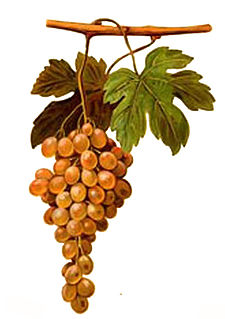
Pedro Ximénez is the name of a white Spanish wine grape variety grown in several Spanish wine regions but most notably in the denominación de origen (DO) of Montilla-Moriles. Here it is used to produce a varietal wine, an intensely sweet, dark, dessert sherry. It is made by drying the grapes under the hot sun, concentrating the sweetness, which are then used to create a thick, black liquid with a strong taste of raisins and molasses that is fortified and aged in solera.

A pisco sour is an alcoholic cocktail of Peruvian origin that is typical of the cuisines from and Chile. The drink's name comes from pisco, which is its base liquor, and the cocktail term sour, in reference to sour citrus juice and sweetener components. The Peruvian pisco sour uses Peruvian pisco as the base liquor and adds freshly squeezed lime juice, simple syrup, ice, egg white, and Angostura bitters. The Chilean version is similar, but uses Chilean pisco and Pica lime, and excludes the bitters and egg white. Other variants of the cocktail include those created with fruits like pineapple or plants such as coca leaves.

Zivania or zivana is a Cypriot pomace brandy produced from the distillation of a mixture of grape pomace and local dry wines made from Xynisteri and Mavro grapes. The name of zivania is derived from zivana which means pomace in the Greek dialect of Cyprus. Zivania is colourless and alcoholic with a light aroma of raisins. Its alcohol content varies, with 45% by volume being the typical value. As defined by law, zivania shall not have more than 60% alcohol content. Zivania contains no sugars and has no acidity.
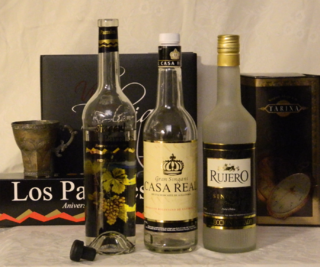
Singani is distilled from white Muscat of Alexandria grapes. It is produced only in the Bolivian high valleys and is considered the national liquor of Bolivia and a cultural patrimony. Its character and production methods are closest to eau-de-vie but it is classified as a brandy for purposes of international trade. Singani has been declared a Domain of Origin and a Geographical Indication (GI) by the Bolivian government.
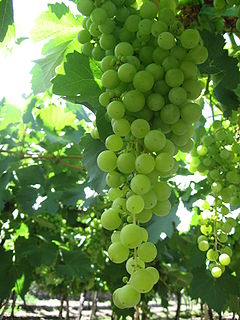
Torrontés is a white grape variety, mostly produced and known in Argentine wine, producing fresh, aromatic wines with moderate acidity, smooth texture and mouthfeel as well as distinctive peach and apricot aromas on the nose. Three Torrontés varieties exist in Argentina: Torrontés Riojano, the most common, Torrontés Sanjuanino, and Torrontés Mendocino. It is primarily Torrontés Riojano that has received attention for the quality of its wines, and is the variety used for most Argentine wines simply labeled Torrontés.

Cascas is a town in Northern Peru, capital of Gran Chimú Province in La Libertad Region.
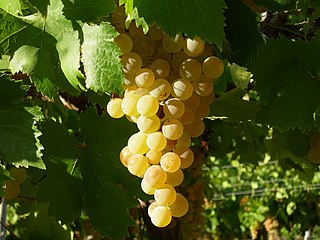
Pedro Giménez is a white Argentine wine grape that is rapidly declining in plantings. Despite the similar name, the Spanish wine grape Pedro Ximénez is a different variety with ampelographers not yet certain if the two grapes are in any way related. Grown predominantly in the Mendoza wine region, Pedro Giménez makes simple wines similar to those made from Cereza and Criolla Grande. There are some plantings in Chile where it is a minor grape in pisco production.
Peruvian wine dates back to the Spanish colonization of the region in the 16th century.
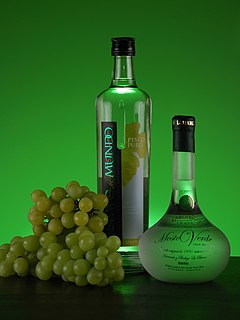
In Peru, pisco is a "designation of origin" that is reserved for the alcoholic beverage belonging to a variety of grape aguardiente produced in Peru since the late 16th century. It is the typical destillate of this country, elaborated from fermented wine of certain grapes, whose value has crossed its borders, as evidenced by the records of shipments made through the port of Pisco to Europe and other parts of the Americas since the 17th century, places such as England, Spain, Portugal, Guatemala, Panama and United States, from the mid-19th century.
The Elqui Valley is a wine region centered on Elqui River in northern Chile. The Elqui Valley Denomination of Origin (DO) is defined by the Chilean appellation system, the legally defined and protected geographical indication used to identify where the grapes for a wine were grown. The region lies 400 km (250 mi) north of Santiago, at the southern end of the Atacama Desert in the Coquimbo region. It is known for producing table grapes and other fruits, as well as pisco brandy, Chile’s most popular liquor. It is considered the most commercially viable wine-producing region of northern Chile.
Monteluz is a Peruvian pisco distillery producing limited amounts of multivarietal pisco using the Mosto Verde technique, which consists of distilling young wines before all the sugars in them are fully converted into alcohol. Due to the small quantities produced and high prices commanded, as well as its dedicated group of enthusiasts in the Peruvian gastronomic sector, Monteluz is often considered a "cult pisco" and is promoted as such by the country's diplomatic envoys abroad.















